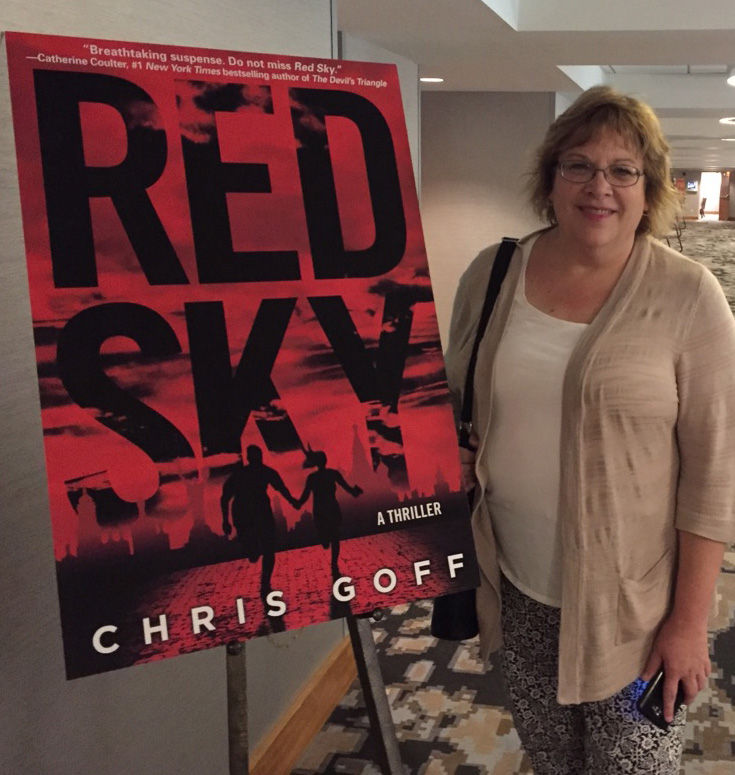The Art of Going DEEP: Part 1
By Chris Goff

Over the years, I’ve spoken at writer’s conferences ad nauseum about plotting the novel, researching the novel, creating characters, writing realistic dialogue and boots on the ground settings. All very important elements of a great novel. Then a few years ago, I was asked to teach a workshop at International Thriller Writers CraftFest. Wanting to something different, I took a hard look at the truly great books I’ve read over the years, and realized, they all have something more. A je ne sais quoi, something that grabs readers and propels the books straight onto the bestsellers list.
We’ve all read books like that. Novels that make us feel like we’re living the moment. We laugh. We cry. Our hearts pound.
One in a million writers is so gifted that their words hit the page with that perfection. For the rest of us, it’s accomplished by digging DEEP. Restructuring. Revising. Polishing. Rewriting. And the place to start is looking to the masters.
Developing CONCEPT.
Michael Palmer, the New York Times bestselling author of medical thrillers, used to say, “Finding what to write about is a little bit like following the recipe for rhinoceros stew. First, find a rhino.” In other words, find the BIG idea, the BIG theme, the BIG universal lesson or message that stretches through your story. What is it you want your reader to take away when they’re done reading your book? That’s your theme, and it needs to be a rhino.
Crafting the Controlling Premise.
Once you’ve found your concept, you have to learn how to harness it, how to wrestle it into submission. If you don’t, it can easily get away from you.
Mark Sullivan, author of #1 bestseller Beneath a Scarlet Sky, taught me this technique. Essentially, it’s how to create a log line that expands on your book’s concept. Here are the elements:
- The hero – Who is your protagonist?
- The conflicts/stakes – What’s the problem? What incites the protagonist to act?
- The anti-hero/antagonist – Who or what stands in the protagonist’s way?
- The setting – Where is this all happening?
And, if germane,
- The mood/atmosphere – What type of book are you writing? Is it funny? Scary?

The trick is boiling it down into two sentences. Trust me, what sounds simple, can take hours. The Controlling Premise must contain everything you plan to write about, because everything you put in the pages of your book must pertain to the premise.
For my Anthony-nominated thriller, Dark Waters, here’s what I came up with:

Apply the “everything rule,” and you’ll find everything in my book plays back to my controlling premise.
Try it for yourself. Take a book, any book, and break it down to its controlling premise. In the end, you will find a strong roadmap for the book in hand—or you’ll find out what you need to do to fix it!
Finding Point of View
Next, you need to figure out whose story you’re telling. That’s the person’s whose head you’re going to live in from start to finish. In a multiple viewpoint story, you may live in several heads, but you must be immersed.
POV is the character’s perspective through which the reader sees the scene. Some authors liken it to the lens of a camera. Whoever is holding the camera is the person whose view we see. Deep point of view is when the writer immerses herself so deeply in the character’s skin that any external narrator disappears.
—Writing Deep POV by Barbara Wallace
In other words, BE THAT CHARACTER. Deep POV is an art. Find the point where your book moves from a story being told by a writer to a story that breathes through the character, and you’ll have a story with emotional punch.
Deep POV is emotion. We all love books that make us laugh, cry, feel scared to death. As humans, we spend a lot of our lives hiding our emotions, masking them. It’s what keeps writers from writing certain things. The fear people might think you’re psychotic or fear of what your mother might think. As a writer, however, it falls to us to put our characters through the wringer. And, as a result, put our readers through the same emotional experience. We don’t just want the reader to feel frightened FOR the character, but to feel frightened as though they ARE the character.
Defining character.
We’ve all been told at some point—by a fellow writer, an agent, an editor—to create character sheets. But the bottom line is, do we really care? No! When most people read a book, they create an image of the protagonist in their head. Maybe they see someone who looks a little like themselves or their husband/boyfriend. Readers want to step into the shoes of the character. They want to know what makes her tick. What makes her cry? What makes her laugh?
Even the villain.
One of the best pieces of advice I was ever given was to “always remember, the villain is the hero of his own story.” Get DEEP in his POV and you will have a villain that’s even scarier because you humanized him.
Getting to know your characters.

Once you’ve figured out whose story you’re telling, you need to spend some time getting to know these people. Put yourself in your characters’ shoes and answer the following questions:
- Who am I?
- What is it I want more than anything?
- How far am I willing to go to get it?
- Why is it so important?
Seem simple? Maybe, but you must really pay attention to the answers. What is your character’s body language when answering? What type of vernacular are they using? Syntax? What is your character’s worldview?
A worldview is shaped by experiences and expectations of self, life, and society. In any given situation, a person brings those aspects to life. How she faces or describes each situation or place is colored by her worldview. Most of our characters—both the good and the bad—are drawn the way they are because of how we see things. As authors, we’re telling the stories only we can tell.

A favorite exercise in writing classes is to give every author the same prompt, and then see what stories emerge. “A young boy walks out of a barn….” One author will write a horror story where the boy is kidnapped, and a statewide manhunt ensues. Another will write a sweet story of a young boy’s exploration of the farmyard. Given twenty authors, no story will be the same, but inevitably one idea will stand out. Why? Because it’s fresh? Maybe. Because it’s timely? Maybe.
Or…maybe it’s because the author found a way of telling the story that pulls the reader in and refuses to let them go. Maybe because the author DUG DEEP.
Dear Readers, is there a book that you’ve read that will forever stay in your mind or heart? How do you think the writer pulled you in?
In her next blog, Chris Goff will explore some examples and share some specific techniques for plumbing the depths of story and emotion. Stay tuned for TOTAL IMMERSION—the Art of Going DEEP: Part II.
Want to read further on this topic? See what our other Rogues suggest in the articles below!
















































Terrific list of what’s important for writers — I don’t believe I’ve ever found a rhino — but I did find that I loved reading DARK WATERS. Kudos to Chris here for giving new writers – and reminding published authors — of how to craft a great story!!! As for a book that stayed in my mind – I would suggest the recent releases by Marie Benedict. Loved them all.
Thanks for the comments and book suggestions. The very best thing about being a writer is the community of writers. Together we make each other better! I am forever grateful to have my fellow rogues to keep me focused and honest!
I love that quote about villains, Chris. You’ve got to much richness in this post. The two liner sometimes takes more time than the whole book! Well, practically. Another boil-it-down challenge is…title. on my mind right now. Looking forward to your next installment!
Titles are extremely difficult. Best of luck finding just the right one, Jenny.
Such a great article, Chris. Getting deeply inside the head of a truly heinous villain can be a challenge, but it definitely pays off just as much as inhabiting the mind of a hero. (When writing villain scenes, there are times when I feel like I have to take a shower after I finish writing, LOL.)
As far as books go, The Hunger Games trilogy truly takes this to the next level. We are so deep in the mind of Katniss Everdeen that we feel her pain and anguish. Suzanne Collins’ choice of first person present tense narration helps with this.
The Hunger Games is a great example of a rhino and DEEP writing, Isabella. As for you, I agree with the shower. Villains can make your skin crawl.
I love this–especially the everything rule.
You’ve also reminded me that in my current work in progress, we really don’t get to know our villain at all.
Hmmm.
Time to dig deep and take a hard look at that bad guy, Lisa. The book will be better for it.
Thinking of books that pulled me in…as far as characters, anything by Michael Koryta. As far as the book as a whole, A Place of Execution by Val McDermid.
Val McDermid rocks!